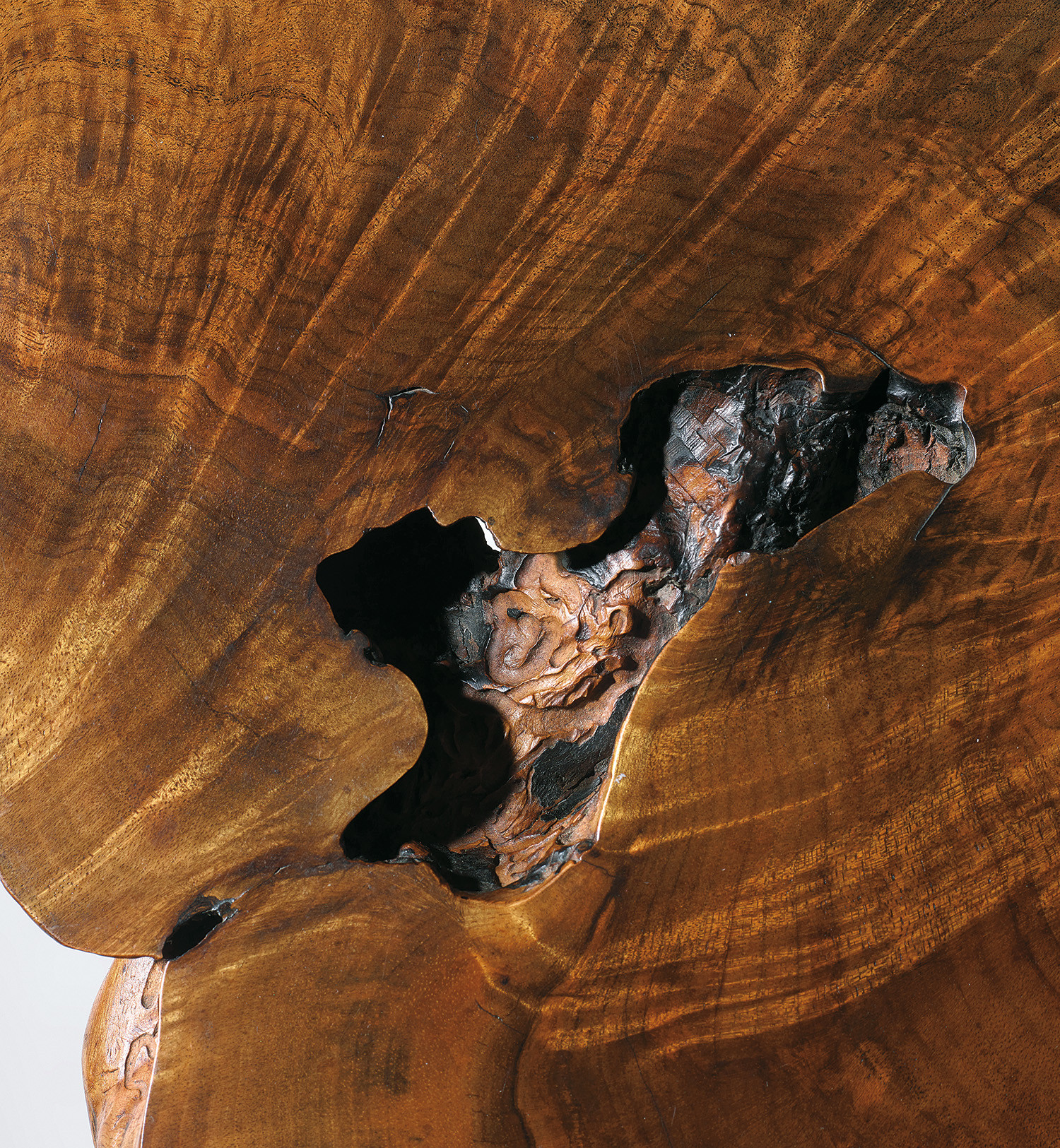



82
George Nakashima
'Minguren I' coffee table
Full-Cataloguing
In the summer of 1976 a lively debate took place in the ‘Letters’ column of the journal Craft Horizons regarding George Nakashima’s 'Conoid' chair. Responding to a 'Conoid' chair that had been depicted in the February 1976 issue as part of an exhibition of contemporary furniture at the Cincinnati Art Museum, Paul Killinger of Boulder, Colorado expressed his ‘profound shock and even despair’ regarding the chair’s cantilevered construction, which he described as ‘structurally terrifying’ (‘Letters’, Craft Horizons, June 1976, p. 13). Mr. Killinger could not conceive how the joint of the seat and vertical back rails, with no front leg support, would hold up under any use. Nakashima published a letter of response in the next issue. He noted that his studio had already been producing this design for fourteen years and to his knowledge, ‘the particular joint that Killinger is so ‘terrified’ about has never failed’ (‘Letters’, Craft Horizons, August 1976, p. 13).
Indeed decades later, the 'Conoid' chair has endured and gone on to assume its rightful place in the canon of twentieth-century design. Killinger clearly did not understand that George Nakashima was an MIT-trained architect, thoroughly-schooled in engineering and the structural properties of materials. Though Nakashima, as a leader of the American studio furniture movement, is revered for elevating the inherent beauty of natural wood in his furniture, the brilliant engineering that underpinned his highly original designs is often overlooked. Nakashima also learned sophisticated joinery techniques through apprenticing with a Japanese carpenter. ‘As an architect, I appreciate theory’, he wrote, ‘but the empirical test of time is the truest test of a product; this chair has passed this test’ (Ibid). Nakashima folded all of these experiences into the design of the 'Conoid' line of furniture, which was inspired by the curved vault of the Conoid studio he had constructed on his compound in New Hope, Pennsylvania.
Perhaps Leticia Kent, who commissioned the following six lots and acquired her set of 'Conoid' chairs the same year as the letters between Nakashima and Killinger appeared in Craft Horizons, was drawn to the architectural aspect of Nakashima’s furniture. Ms. Kent studied architecture at the Pratt Institute and The Cooper Union in New York and worked for several architects including Giorgio Cavaglieri. However, in the late 1960s she took up a second career as a journalist, contributing to the Village Voice, the New York Times, and Vogue, among other publications. Her subjects ranged from pollution to urban design and show business. An active member of her community, she was also a founding member of the Greenwich Village Society for Historic Preservation.
Beyond architecture, Ms. Kent and Nakashima shared an interest in India and Hinduism. In a 1968 letter in which Nakashima responded to clippings from the Village Voice that Kent had sent him, he relayed his experiences in India, where he was a member of Shri Aurobindo Ashram in Pondicherry and even became a Hindu Monk. It is a deeply felt letter and demonstrates the close friendships and bonds that formed between Nakashima and his clients.
George Nakashima
American | B. 1905 D. 1990Working out of his compound in rural New Hope, Pennsylvania, George Nakashima produced some of the most original and influential furniture designs of the post-war era. Nakashima aimed to give trees a second life, choosing solid wood over veneers and designing his furniture to highlight the inherent beauty of the wood, such as the form and grain. To this end, his tables often feature freeform edges, natural fissures and knot holes. Nakashima was an MIT-trained architect and traveled widely in his youth, gaining exposure to modernist design the world over.
The signature style he developed was the distillation of extraordinary, diverse experiences, which led to the establishment of his furniture-making business in 1946. In particular, his practice of Integral Yoga, which he studied while working under the architect Antonin Raymond on the construction of the Sri Aurobindo Ashram in Pondicherry, India, had a lasting impact on his philosophy as a designer.
After returning to the U.S. in 1940, Nakashima's family was interned in an American concentration camp, a horrible ordeal that nevertheless introduced him to traditional Japanese joinery by way of a Nisei woodworker he met in the camp. He incorporated these techniques and also drew on American vernacular forms, such as the Windsor chair. These diverse influences have resulted in immense crossover appeal in the world of twentieth-century design collecting.